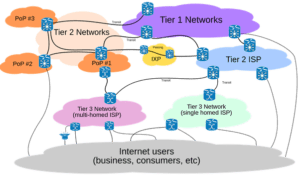The DNS (Domain Name System) is one of the most significant internet services in existence, without which we wouldn’t be able to access any online content or even send an email. In fact, every time we try to connect to a website or any other online service, DNS root server help our computers find and reach the desired addresses. To acquire information online, humans search through domain names like amazon.com, myntra.com; DNS involves translating this into IP addresses for the content to load.
How does DNS Root infra work?
When a user types an address name into the browser, the operating system checks the information in local cache system. If not found, a query seeking to match the domain name with its IP address is send over the Internet to find the website which is often provided by your ISP(Internet Service Provider). The first server the ISP interacts with is the Recursive Resolver which is the first designed to receive queries through applications such as web browser. The recursor will make requests to the website assuming that it already has a response cache and if not it goes through DNS hierarchy in order to satisfy the client’s DNS query. The recursive talks to first type of DNS server called Root Server. It translates the human readable hosts into IP addresses. The top level domain (TLD) server is the next step in the search for a specific IP address, and it hosts the last portion of a hostname (In amazon.com, the TLD server is “com”). The TLD server will then return the Authoritative Name Server where the desired domain is stored. This is when the server that made the request sends a query to the authoritative server hosting the zone of the domain in question. Once the request has reached the authoritative server, it will respond to the requesting server that is recursive resolver with the IP address for www.example.com. The browser can send request to view the website’s content using the IP address that it received.
Types of DNS Queries:
- Recursive Query:In recursive query, a DNS client provides a name resolution, and the DNS Resolver “must” provide an answer – it either responds with either a relevant answer that is record, or an error message if it can’t be found.
- Iterative Query:In an iterative query, the name server, will not go and fetch the complete answer for your query, but will give back a referral to other DNS server’s, which might have the answer. This process continues with additional DNS servers down the query chain until either an error or timeout occurs.
- Non-recursive Query:In this kind of query, DNS resolver already knows the answer. It immediately returns because the answer already exists in the cache. In such cases, a response is immediately returned to the client.
The whole process of requesting a server might seem complicated, but in real, query resolution take place in a blink of an eye. This is just a step-by-step process which is faster than tenths of second.
DE-CIX India is an Internet Exchange in India that hosts Route Server Peering and DNS Root Servers to improve the DNS queries by its connected networks and helps them to optimize the time required to resolve the DNS queries. There are 13 such DNS root servers available in the world out of which DE-CIX India hosts 4 of them such as PCH, Verisign, RIPE Atlas Probes and K-Root Server. DE-CIX India currently interconnects around 175+ networks and all these networks are able to peer with these DNS root servers through its platform. Reach out to us in case if you wants to peer with these DNS root Servers.
We hope the above blog seems more informative to you and able to value add to your knowledge. Do let us know your feedback / concerns if you think something needs to be corrected or added.



